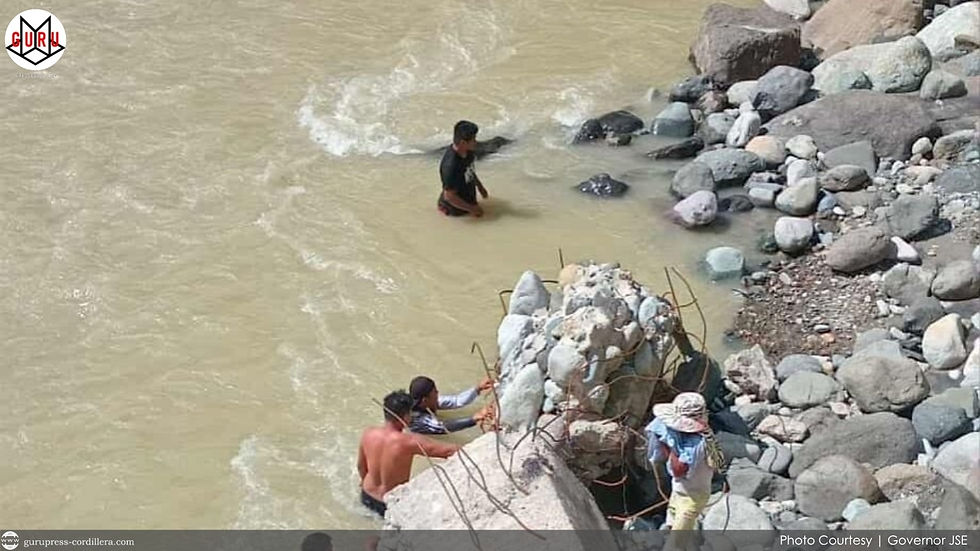

Cup of Joe declines invitation: ‘Unfortunately, fully booked da idiay dates iti celebration tayo ti Kalinga Day,’ - Concert Committee Co-chair BM Donaal on Bodong Festival updates
Tabuk City, Kalinga – After several attempts, Organizing Committee Co-Chairman and Board Member Christopher Donaal confirmed that the anticipated Baguio-based band Cup of Joe has declined the invitation to perform at the upcoming Kalinga Day celebration, citing a fully booked schedule on the event dates. As the 31st Kalinga Founding Anniversary and 7th Bodong Festival draw near, the four-night concert to be held at the Capitol Park in Bulanao from February 11 to 14 is set to

Lorraine Bacullo
5 hours ago2 min read
MLGU Balbalan backs young champions with CASH incentives after 2026 Kalinga Provincial Meet Success
Balbalan, Kalinga – Winning iBalbalan athletes in the 2026 Kalinga Provincial Athletic Meet are set to receive cash incentives from the Municipal Local Government Unit (MLGU), according to Mayor Almar Malannag. Balbalan hauled a total of 198 medals—58 gold, 76 silver, and 64 bronze—in the province-wide sports festival held in Taga, Pinukpuk from January 13 to 17, placing third overall in the medal tally. With youth empowerment as one of the key priorities of Mayor Malannag’s

Balbalan LGU
5 hours ago1 min read


FEATURE: Double bar triumph: Isabela father and daughter story of passing the 2025 Bar Examinations
Cauayan, Isabela – When the results of the 2025 Bar Examinations were released, a wave of joy, relief, and pride swept through a family in Isabela as a father and his daughter discovered that they had both passed—marking a rare and inspiring shared achievement. The 2025 Bar Examinations, administered nationwide by the Supreme Court, drew thousands of law graduates aspiring to join the country’s legal profession. Out of 11,420 examinees who completed all three days of the exam
Mark Jordan Bomogao
5 hours ago2 min read


Modern training facilities rise at PMA to strengthen future military leaders
Baguio City, Philippines – Thousands of future military leaders are set to benefit from a partnership between SM Prime Holdings Inc. and the Philippine Military Academy (PMA), aimed at boosting leadership development and physical training at Fort Del Pilar in Baguio City. The partnership was formalized through the signing of a Memorandum of Agreement on January 16, 2026. Under the agreement, SM Prime will support the construction of the Henry Sy Sr. Hall inside the academy. T
Mark Jordan Bomogao
5 hours ago2 min read


FEATURE: 31 Years of Service, One Long Wait: Benguet teacher finally promoted after 20 YEARS
After two decades of waiting, Marcelina Gosgos, a public school teacher at Balili Elementary School in La Trinidad, Benguet, has finally received her first promotion in her 31-year teaching career during the Mass Oath-Taking Ceremony cum Growth Mindset Priming for Newly Reclassified and Promoted Teachers and School Leaders held at the Benguet Sports Complex in Wangal, La Trinidad, on January 5, 2026. The long-awaited advancement was made possible through the Department of Edu

Lorraine Bacullo
5 hours ago2 min read


Quick-acting cop saves toddler locked inside car in Isabela
Santa Maria, Isabela – A two-year-old child was successfully rescued by a responding police officer after being accidentally locked inside a car parked at a town market in Barangay Poblacion 1, Santa Maria, Isabela, on January 20, 2026. According to a report from the Santa Maria Municipal Police Station, the toddler was left inside the vehicle for a short time while the grandmother went to buy vegetables at the market. The grandmother told police that the car engine was runni

Mark Moises Calayan
21 hours ago2 min read


From Farms to Festival: Kalinga Bodong Agro Fair 2026 opens Feb. 12–14, seeks to boost agro-tourism and local livelihood
Tabuk City, Kalinga – As part of the province’s annual Bodong Festival, the Kalinga Agro-Tourism Fair is set to open anew from February 12 to 14, 2026, at the Capitol Tourism Park in Bulanao, Tabuk City. The schedule of the Agro-Tourism Fair was confirmed during recent stakeholder meetings headed by Governor James S. Edduba, as part of the preparations for the 31st Founding Anniversary of Kalinga and the 7th Bodong Festival this February. Aiming to boost the provincial econom

Mark Moises Calayan
21 hours ago2 min read


“Maging aware po tayo… dito kasi pag nahuli kayo at na-ticketan, hindi po valid yung reason na ‘Ay, turista po kami.’ ” - Baguio police to tourists coming for Panagbenga
Baguio City, Philippines – With preparations for the 30th edition of the Flower Festival underway, the Baguio City Police Office (BCPO) reminds tourists planning to visit the country’s Summer Capital to act as if they are visiting another country—know the norms, rules, and regulations, and strictly abide by them. “A gentle appeal or reminder po sa ating mga tourists who will be coming to Baguio this Panagbenga: ‘yung attitude po sana na dadalhin natin is ‘yung behavior natin

Menchie Kinao-Puerto
1 day ago2 min read


‘Nginmato ti crimes … maysa gapo ket daytoy sugal’ - BM Donaal on crafting ordinance banning gambling inside “peryahan” in Kalinga
Tabuk City, Kalinga – Seeking to protect young people from the harmful effects of gambling that could lead them to unlawful activities, the Sangguniang Panlalawigan of Kalinga recently approved on third reading a proposed ordinance banning all gambling activities inside amusement parks (peryahan) in the province. Entitled “Institutionalizing Safeguards Against Gambling and Youth Exploitation in Peryahan Operations in the Province of Kalinga,” the ordinance was authored by Boa

Mark Moises Calayan
1 day ago2 min read


Gov. Edduba proposes elementary school for Sitio Laytoc after seeing children walk kilometers to class
Pakawit, Pinukpuk – Sitio Laytoc in Barangay Pakawit, Pinukpuk is set to have its own elementary school following Governor James S. Edduba’s proposal to establish an extension classroom in the sitio, underscoring the provincial government’s commitment to bringing basic education closer to children in remote communities. The proposal was raised during the Provincial Sports Council meeting held at the Conference Hall in Capitol Hills, Bulanao on January 19, 2026, after the gove

Lorraine Bacullo
1 day ago2 min read


‘Strong values at home build champions in life and in service’ – Mayor Abay on victory of yTinglayan soldier at 33rd ASEAN Armies Rifle Meet
Tinglayan, Kalinga – The entire Municipality of Tinglayan takes pride in the international achievement of its son, Sergeant Joker So-ang, who emerged as the overall champion in the 33rd Association of Southeast Asian Nations (ASEAN) Armies Rifle Meet held in Singapore. So-ang, who hails from Buscalan, Tinglayan, is a member of the Philippine Army Shooting Contingent (PASCON) that competed in the event from November 18 to 28, 2025. The ASEAN Armies Rifle Meet is an annual shoo

Leonora Lo-oy
1 day ago1 min read


WHAT’S NEXT?: After SC ruling, recanvass seen as final step before Tabuk City No. 1 Councilor Comafay takes office
Tabuk City, Kalinga – Anti-corruption crusader Atty. Errol Comafay can soon become the voice of the people in the City Council of Tabuk. Now that none other than the Supreme Court has reversed Comafay’s disqualification in the May 2025 elections, Tabukeños who gave him the majority of the votes and placed him number one are eagerly awaiting his assumption of office. On January 14, the Supreme Court overturned the decision of the Commission on Elections to cancel Comafay’s Cer

Leonora Lo-oy
1 day ago2 min read


FEATURE: ‘Hindi ko Inasahan….’ – Vlogger from Isabela gets GMA spotlight
An Isabela-based vlogger who once questioned why a small content creator like him would ever be noticed among countless online personalities has found himself in the national spotlight after being featured on national television—particularly on One North Central Luzon produced by the GMA Regional TV Team, a milestone he admits he never expected to achieve. Mark Fillord Gumaru, popularly known as Mark Vlog, 25, from Delfin Albano, Isabela, began his vlogging journey during the

Lorraine Bacullo
1 day ago3 min read


SNATCHER IN TABUK CITY: Man pretending to Cash In for GCash snatched shop owner’s phone
Tabuk City, Kalinga – An unidentified man who was supposed to cash in on GCash snatched a shop owner’s cellphone on Sunday afternoon, January 18, in Purok 4, Bulanao. The man was wearing a cap and a facemask when he arrived at the shop located along the Villoria Street at 3:48 p.m. Based on CCTV footage, the man was talking to someone over the phone before he asked the woman minding the shop to cash in. “Ma’am, pwedeng magpa-QR?” the man asked, referring to transferring a GCa

Leonora Lo-oy
2 days ago1 min read


Family brings home OFW who died in Baguio City Hotel fall
Tabuk City, Kalinga – A wake is being held in Tabuk City, Kalinga for the man who fell from a hotel in Baguio City on January 16. The 31-year-old victim, identified as an Overseas Filipino Worker (OFW) who was on vacation, sustained serious injuries after falling from the fifth floor of a hotel along Abanao Street. A witness said the man was seen climbing over the balcony and later hanging from the iron railing before allegedly losing his grip and falling. He landed on the re

Leonora Lo-oy
2 days ago1 min read

.png)













































































Comments